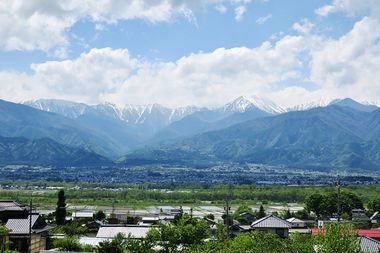Difference between revisions of "Rietic Mountains"
m |
|||
| Line 8: | Line 8: | ||
| photo_size = | | photo_size = | ||
| photo_alt = | | photo_alt = | ||
| photo_caption = Rietic Mountains seen from the Lugid side in | | photo_caption = Rietic Mountains seen from the Lugid side in Tiracho, Metni | ||
| map = | | map = | ||
| map_image = | | map_image = | ||
| Line 19: | Line 19: | ||
| country2 = {{flag|Liosol}} | | country2 = {{flag|Liosol}} | ||
| country3 = {{flag|Lugida}} | | country3 = {{flag|Lugida}} | ||
| country4 = | | country4 = | ||
| range_coordinates = 40°N 0°E | | range_coordinates = 40°N 0°E | ||
| label = | | label = | ||
| Line 52: | Line 52: | ||
}} | }} | ||
The '''Rietic Mountains''' are a mountain range | The '''Rietic Mountains''' are a mountain range in [[Soltenna|East Soltenna]], forming the boundary between the [[Central Basin]] to the west and the Rietic Basin to the east. Stretching {{convert|2000|km|mi|abbr=on}} between the [[Amiyant Sea]] and Belfan Valley, the range extends from north to south across three countries: [[Liosol]], [[Kadya]], and [[Lugida]]. | ||
Along their length, the Rietic are split into two belts; the main Rietic range spans from Southern Kadya into the eastern border of Liosol, while the Eastern Rietic is located wholly within Lugida, separated from the main range by Retuk Pass. The highest peaks in the Rietic are [[Mount Ramiel]] on the southern edge of Eastern Rietic, which rises to a height of {{convert|5480|m|ft}} above sea level; nearby [[Mount Sherun]] at {{convert|4143|m|ft}}; and [[Mount Metni]] on the Kadya-Lugida border at {{convert|3595|m|ft}}. | |||
==Etymology== | ==Etymology== | ||
The | The name ''Rietic'' derives from the [[Iris language|Iris]] ''Ṛŵyet'' “high place”, comprised of ''ṛŵ'' “high, upper, great, supreme”, and ''yet'' “place, site”. ''Ṛŵyet'' was used to refer to the dry eastern highlands of [[Ancient Iris]] which are primarily inhabited by Kadic tribes. The word is loaned into [[Rudanian]] as ''Rûyet'', which ultimately became [[Lithian]] ''Riyet''. ''Riyet'' by itself is used to refer to the mountain range. The [[Rietic languages|Rietic ethnolinguistic group]] takes its name from the mountain range. | ||
==Geography== | ==Geography== | ||
Revision as of 14:13, 21 October 2020
| Rietic Mountains | |
|---|---|
 Rietic Mountains seen from the Lugid side in Tiracho, Metni | |
| Highest point | |
| Peak | Mount Lenthir |
| Elevation | 5,480 m (17,980 ft) |
| Coordinates | 31°33′23″N 0°27′02″E |
| Dimensions | |
| Length | 2,000 km (1,200 mi) |
| Width | 160 km (99 mi) |
| Geography | |
| Location | Soltenna |
| Countries | |
| Range coordinates | 40°N 0°E |
The Rietic Mountains are a mountain range in East Soltenna, forming the boundary between the Central Basin to the west and the Rietic Basin to the east. Stretching 2,000 km (1,200 mi) between the Amiyant Sea and Belfan Valley, the range extends from north to south across three countries: Liosol, Kadya, and Lugida.
Along their length, the Rietic are split into two belts; the main Rietic range spans from Southern Kadya into the eastern border of Liosol, while the Eastern Rietic is located wholly within Lugida, separated from the main range by Retuk Pass. The highest peaks in the Rietic are Mount Ramiel on the southern edge of Eastern Rietic, which rises to a height of 5,480 metres (17,980 ft) above sea level; nearby Mount Sherun at 4,143 metres (13,593 ft); and Mount Metni on the Kadya-Lugida border at 3,595 metres (11,795 ft).
Etymology
The name Rietic derives from the Iris Ṛŵyet “high place”, comprised of ṛŵ “high, upper, great, supreme”, and yet “place, site”. Ṛŵyet was used to refer to the dry eastern highlands of Ancient Iris which are primarily inhabited by Kadic tribes. The word is loaned into Rudanian as Rûyet, which ultimately became Lithian Riyet. Riyet by itself is used to refer to the mountain range. The Rietic ethnolinguistic group takes its name from the mountain range.
Geography
Notable peaks
Orogeny and geology
The Rietic orogeny began with the collision between the West Soltennan Plate and the Rietic Plate approximately 90 million years ago. Initially both plates collided to form a faultline along its convergent boundary. The Rietic Plate would slide southwards along with the larger Mirarian Plate. As the Akulanen Plate broke off from the Baredinan Plate, it began to move northwest at high velocity against the Rietic Plate while opening the Gulf of Sharkunen. Rocks along the Rietic faultline were in turn forced upward and the boundary ceased to become a faultline, starting the process of mountain formation in the area.
Both the Rietic and the Akulanen Plate would continue to move northwards and fold towards each other. This made the Rietic Plate's slightly mountainous landscape. Ultimately the plate would merge with the Soltennan Plate.
Approximately 65 million years ago the Akulanen Plate started to subduct under the Rietic Plate. During this time volcanic and tectonic activity on the area increased. Volcanism would form most of the southern Rietic Mountains including Mount Lenthir and the Xynden Islands. Much of tectonic activity along both boundaries have subsided, however the southern parts remain to be active and in recent times have caused a number of major earthquakes, such as in 872 and in 1730 off the coast of Kenasha and Raushire respectively.